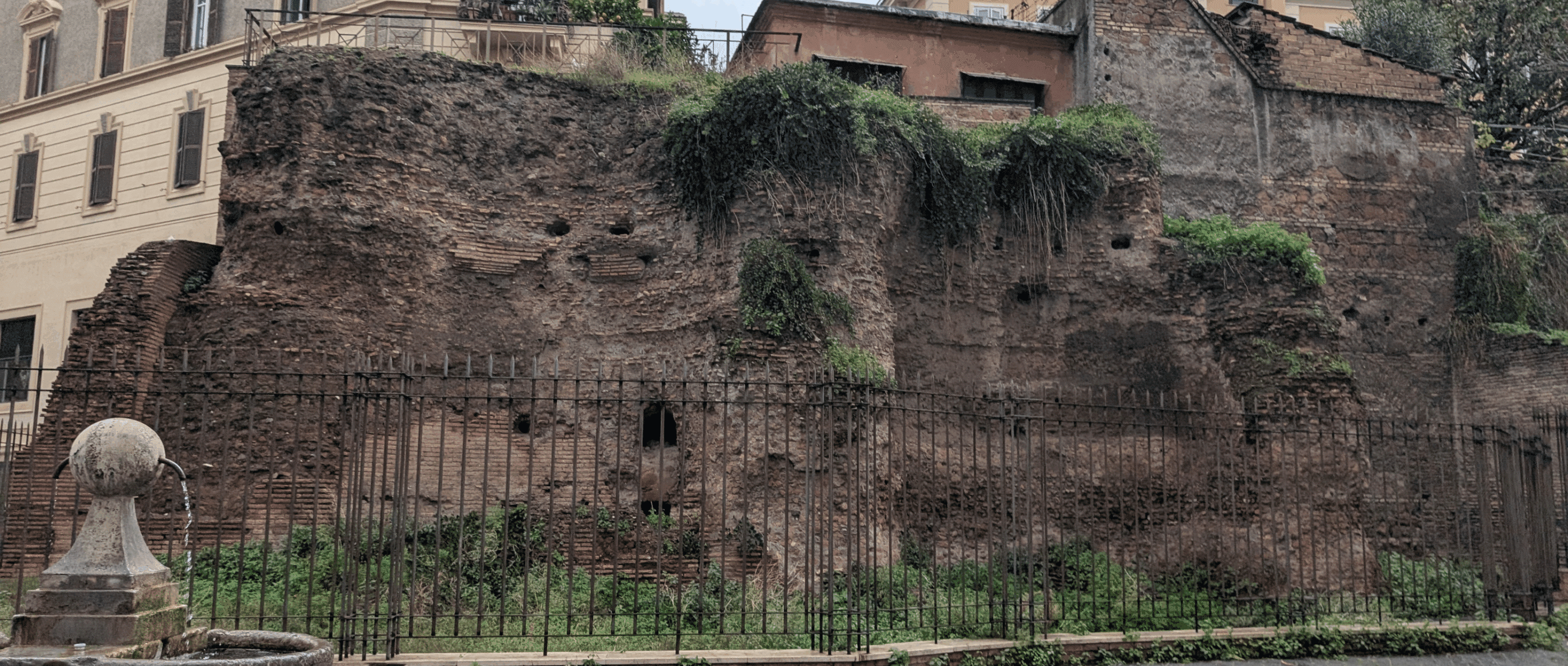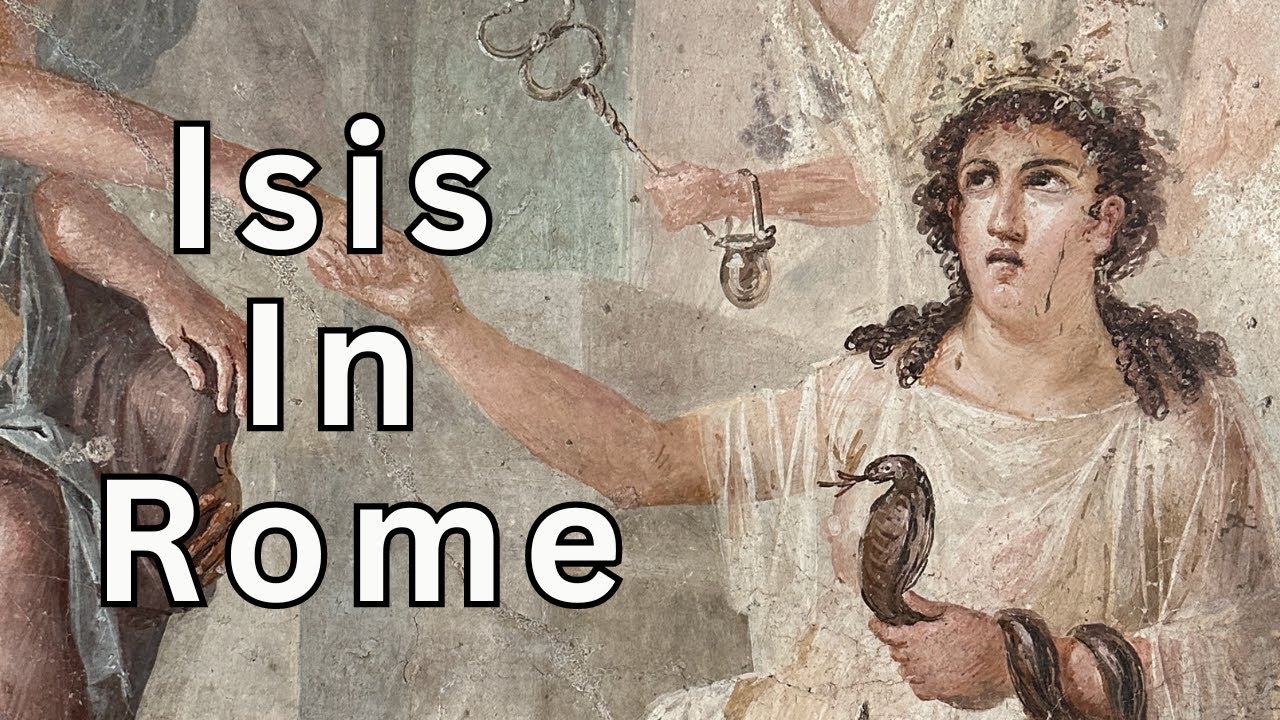Start with our video overview:
Isis, the mother of Horus, was closely tied to the fertility of the Nile River and became one of the most important goddesses of the ancient Mediterranean world. Her cult spread far beyond Egypt and took root in Rome, where it became linked to the vital grain shipments that sustained the city. Evidence of her worship can still be found across the Roman world in statues, sanctuaries, and other forms of iconography. In Rome, she was often venerated together with Serapis, a deity that blended elements of Osiris and the sacred bull Apis.
The cult of Isis first reached Italy around 140 BCE, brought by traders from the island of Delos. From there it spread quickly to coastal towns. At Pompeii, the remains of a temple dedicated to Isis have been preserved, while in nearby Herculaneum scenes of Egyptian-inspired worship appear near the theater. In the harbor town of Puteoli, the macellum (market) contained a Temple of Serapis. At Praeneste, a city famous for its sanctuary of Fortuna Primigenia, images of Isis were incorporated into the complex, including a colossal statue and the famous Nile mosaic.
By the late Republic and early Empire, the cult of Isis was firmly established in Rome itself. Around 80 BCE a large sanctuary known as the Iseum Metellinum was built on the Esquiline Hill. Rebuilt during the Imperial period, it became so prominent that it gave its name to one of Augustus’ fourteen regions of the city. The popularity of Egyptian culture in Rome grew even further after the defeat of Cleopatra, sparking a wave of Egyptomania. Obelisks, such as the one placed on the spina of the Circus Maximus, were brought back from Egypt as trophies of war.
The grandest center of worship was the Temple of Isis and Serapis in the Campus Martius, located near the Pantheon. Although the temple itself has not been fully excavated, archaeologists have recovered a wealth of statues and artifacts. These include colossal statues of Isis, fragments of a Serapis cult statue, priestly figures, and stone carvings of Egyptian animals. A relief showing what may have been the temple’s actual appearance has also survived.
The influence of Isis extended into imperial residences. Traces of her cult have been found in Augustus’ house on the Palatine and in Nero’s Domus Aurea. Romans turned to Isis not only as a goddess of fertility and abundance but also as a divine protector of trade and grain shipments, making her especially important to the city’s food supply. This connection can be seen in places like Ostia, Rome’s harbor city, where a fresco known as the Isis Geminiana decorated a tomb.
Isis also appears in many works of Graeco-Roman art. One of the most notable is the Farnese Cup, where Isis is depicted sitting on a sphinx. Originally owned by the Ptolemaic dynasty, the cup entered the Roman imperial collection and eventually made its way to Constantinople. Today it can be seen in the Archaeological Museum of Naples.
Through her temples, art, and widespread cult, Isis became one of the most prominent foreign deities integrated into Roman religion. Her worship reflected Rome’s deep fascination with Egypt, while also underscoring the practical importance of Egyptian grain to the survival of the empire.
Bibliography:
- “Fresco Depicting the Boat Isis Geminiana.” Vatican Museums. https://www.museivaticani.va/content/museivaticani/en/collezioni/musei/sala-delle-nozze-aldobrandine/affresco-raffigurante-limbarcazione-isis-geminiana.html
- Mackay, Danielle. (2021). “Serapis and Isis: Religious Syncretism in the Greco-Roman World.” The Collector. https://www.thecollector.com/serapis-and-isis-religious-syncretism-in-the-greco-roman-world/
- Metcalfe, Tom. (2023). “Ancient Romans Sacrificed Birds to the Goddess Isis, Burnt Bones in Pompeii Reveal.” Live Science. https://www.livescience.com/archaeology/romans/ancient-romans-sacrificed-birds-to-the-goddess-isis-burnt-bones-in-pompeii-reveal.
- Platner, Samuel. (1929). “Aedes Isidis.” In A Topographical Dictionary of Ancient Rome (p.283-285). Retrieved from: https://penelope.uchicago.edu/Thayer/E/Gazetteer/Places/Europe/Italy/Lazio/Roma/Rome/_Texts/PLATOP*/Aedes_Isidis.html
- Strabley, Eloise. (2025). “Temple of Isis at Pompeii.” Connecticut College. https://openpress.digital.conncoll.edu/religionsofgreeceandromesitereports/chapter/temple-of-isis-at-pompeii/
- Swetnam-Burland, Molly. (2015). “The Sanctuary of Isis in Pompeii: Dedication and Devotion, Myth and Ritual.” Cambridge University Press. https://www.cambridge.org/core/books/abs/egypt-in-italy/sanctuary-of-isis-in-pompeii-dedication-and-devotion-myth-and-ritual/E0D38027A5FDFECF548E1B5E42EB7388
This content is brought to you by The American Institute for Roman Culture, a 501(C)3 US Non-Profit Organization.
Please support our mission to aid learning and understanding of ancient Rome through free-to-access content by donating today.
Cite This Page
Cite this page as: Darius Arya, The American Institute for Roman Culture, “The Goddess Isis in Rome,” Ancient Rome Live. Last modified 10/12/2025. https://ancientromelive.org/the-goddess-isis-in-rome
License
Created by The American Institute of Roman Culture, published on 10/12/2025 under the following license: Creative Commons: Attribution-NonCommercial-ShareAlike. This license lets others remix, tweak, and build upon this content non-commercially, as long as they credit the author and license their new creations under the identical terms. Please note that content linked from this page may have different licensing terms.




